The Yaqui
The Yaqui is a 1916 American silent Black and white Melodrama directed by Lloyd B. Carleton and starring Hobart Bosworth, Gretchen Lederer and Emory Johnson. The film depicts Yaqui Indians who are entrapped by nefarious elements into enslavement for a wealthy plantation owner. They struggle in captivity eventually rebelling against their owner's oppression. The film was released on Mar 19, 1916 by Universal.[3][4]
| The Yaqui | |
|---|---|
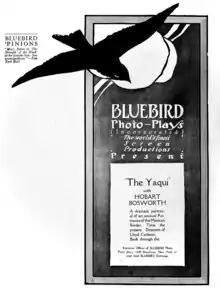 Moving Picture World Ad | |
| Directed by | Lloyd B. Carleton |
| Produced by | Universal Bluebird Photoplays |
| Screenplay by |
|
| Story by | Dane Coolidge |
| Starring | |
| Music by | Max Winkler |
| Color process | Black and White |
Production company | |
| Distributed by | Universal |
Release date |
|
Running time | 5 reels 70 Minutes |
| Country | United States |
| Language | Silent (English intertitles |
Plot
Flores ( Emory Johnson ) is a wealthy Mexican plantation owner. He desperately needs workers for his plantation located in the Yucatán Peninsula. General Martinez, played by Jack Curtis is an Indian-hating commander of a Mexican garrison in the northern district of Mexico. Garrison headquarters are located right in the heart Yaqui Indian lands. Lt. Hernandez (Louis A. Valderna) is the Generals' second in command.
Flores visits the area and approaches General Martinez asking if there are any means of obtaining peons to be field workers on his plantation. Martinez thinks he knows of a way to kill two birds with one stone. Flores and Martinez hatch a plan which will mutually benefit both. Martinez plans to insult the Yaqui leaders' wife - Modesta (Goldie Colwell). Tambor is the Yaqui leader and is played by Hobart Bosworth. Martinez knows Tambor will not let the insult go unanswered. At the feast of Santa Catalina, Martinez approaches Tambor's wife. He takes her in his arms and attempts to kiss her. A mortified Tambor reacts violently.
And now the plan bears fruit. Tambor fully anticipated reaction provokes a Martinez's military response. After the rebellion is put down, the Yaquis are rounded up, including Tambor. Martinez decides to execute Tambor. Someone in the crowd shouts out his avowed hatred of Tambor. He wants to handle the execution personally. Martinez gives him the gun, and the man shoots Tambor. The chief crumples into a pre-dug grave, and the grave is covered. But all is not as it seems. The executioner was part of a counter-plan. He had removed most of the powder in the cartridge, making the shot non-lethal. Tambor was only stunned. Later they exhumed his buried body and revived him.
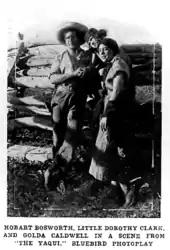
Later on, the subjugated Yaqui start loading trucks for their long trek south to the Flores plantation. Since Tambor is presumed dead, his wife Modesta and his daughter Lucia ( Dorothy Clark ) are just unremarkable part of the Yaqui captives. The clever Tambor disguises himself and joins the caravan to the plantation.
After they arrive at the plantation, the Yaqui are forced to work in the tropical sun for long hours. The family is reunited. His daughter falls ill with the fever. Flores believes the work is more important than a single individual. Tambor and Modesta are not allowed to treat their daughter, and after a short while, she dies.
One night, Flores entices Modesta to come to the big house. After her arrival, he tries to rape her. Instead then endured this humiliation, Modesta stabs herself with her dagger. Then Tambor arrives, sees Modesta, is overwhelmed with emotion, pulls the knife from Modestas' prostrate body, and kills Flores with the same blade. Tambor now becomes the leader of a real rebellion. He gathers his tribe together and heads north to exact revenge from the repressive General Martinez.
Meanwhile, we come to find out both Martinez and Hernandez are in love with a wealthy land owners' daughter. Ysobel (Yona Landowska ) is the daughter of Señor Esteban (Charles H. Hickman) and Señora Esteban played by Gretchen Lederer. Ysobel loves Hernandez, but her parents want her to marry the wealthier general. Both continue to vie for her affection. Hernandez is also becoming sympathetic to the cause of revolutionists.
Tambor arrives in northern Mexico and assembles his forces. Martinez, sensing danger, places his troops on alert. A sensational battle ensues. The Yaquis are victorious, and Martinezs' troops are defeated. Later there is a personal duel between Martinez and Tambor. In the exchange of gunfire, Martinez dies. When the smoke has settled, and everything returns to normal - Hernandez marries Ysobel.
Cast
Actor Role Hobart Bosworth Tambor Goldie Colwell Modesta Dorothy Clark Lucia Emory Johnson Flores Jack Curtis General Martinez Louis A. Valderna Lt. Hernandez Charles H. Hickman Señor Esteban Gretchen Lederer Señora Esteban Yona Landowska Ysobel
Production
Development
- The following factors were influential in this movie's development
- The film's release was serendipitous considering the events of 1916. The Yaqui Indian tribes were based both in Mexico and Arizona with the lion's share located on the Mexican side of the border. The Mexican Yaquis were engaged in a perpetual struggle with the Mexican army and the ruthless plantation owners. In the preceding decades, thousands of Yaquis had died. While these developments provided headlines for the American newspapers, the Yaqui Wars also kept the newspapers stoked. And if this wasn't enough, Pancho Villa continued to generate headlines by battling with the Mexican army and being chased by the American Army.
- In 1913, author Dane Coolidge wrote a novel titled Land of Broken Promises. The novel was published in the 1913 November issue of Munsey's Magazine pages 313 - 404.[5] The magazine paid Coolidge $2,500 (equivalent to $62,056 in 2018) for publishing rights to the novel. In 1915, Coolidge expanded "The land of Broken Promises" into another novel titled - The Desert Trail.[2] Dane Coolidge next movie success would be the story Rimrock Jones sold to Famous Players-Lasky and released under that title on January 21, 1918.[2]
- In addition to writing novels, Coolidge also tried his hand at writing movie scenarios. Over time, he would write four scenarios. A movie company accepted only one. The Yaqui, adapted from his novel "The Land of Broken Promises," was purchased by Universal for $400 (equivalent to $9,929 in 2018).[2] Universal bought the scenario to protect itself, because credit for the screen adaptation is given to well-known scenario writer - Olga Printzlau [1]
- Two Yaqui-themed photoplays preceded Universal's The Yaqui.
- The first film was an American short - The Yaqui Girl. The film was released December 31, 1910. The film is directed by James Young Deer and starred Virginia Chester. The Yaqui Girl was filmed in New Jersey and Santiago Canyon, California. The movie is about a beautiful young Indian maiden falls in love with a Mexican cavalier.[6]
- The second was - The Yaqui Cur a 1913 short film directed by D.W. Griffith. The production was shot entirely in California and featured a romance between a Native American woman and a white man. Prints of the film still exist.[7]
Marketing
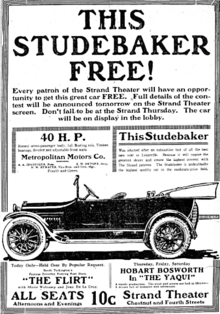
Based on an American Film Institute standard, films with a running time of forty-five minutes or longer are considered feature films. In 1915, feature films were becoming more the trend in Hollywood. In 1916, Universal formed a three-tier branding system for their releases. Universal films decided to label their films according to the size of their budget and status. Bear in mind, Universal, unlike the top-tier studios, did not own any theaters to market its feature films. By branding their product, Universal gave theater owners and audiences a quick reference guide. Branding would assist theater owners in making a judgment for films they were about to lease and help fans decide which movies they wanted to see. This branding system would end in late 1929.
Universal released three different types of feature motion pictures: [8][9]
- Red feather Photoplays – low budget feature films
- Bluebird Photoplays – Mainstream feature release and more ambitious productions
- Jewel – prestige motion pictures featuring high budgets using prominent actors and commanding higher roadshow ticket prices
This film carried Universal’s “Bluebird” brand.
Pre-production
Hobart Van Zandt Bosworth was a well-known Universal actor at the time. Hobart was in his thirties when he made this movie. After Universal signed a 21-year-old Emory Johnson, Hobart thought he saw a potential mega-career for the 21-year-old. Hobart decided to mentor the young actor. After finishing The Yaqui, they immediately went on to make another feature-length Western - Two Men of Sandy Bar. The relationship bore fruit and continued into the next decade.[10]
Early in his stage career, Hobart Bosworth became afflicted with tuberculosis (TB). After a relapse in 1906, he decided to head to the dry climes of the Southwest. He ended up recovering in Tempe, Arizona. A stage actor with a deteriorating voice would find little work on Broadway. Silent movies provided the perfect venue for the next stage of his acting career. By 1916, Bosworth was a well-known actor in silent films. He was cast for the lead in “The Yaqui." Bosworth recommended Universal film some of the exteriors in Tempe. After the completion of the film, Tempe began a long connection with Hollywood.[11]
Filming
This exteriors for this film were shot in both Mexico and Tempe, Arizona. Universal felt shooting major parts in Mexico would lend an air of authenticity to this film. The post-publicity hype; both locations were only a "few hundred miles" west from Columbus, New Mexico.[12] The town of Columbus was very much on the minds of most Americans. On 9 March 1916, Pancho Villa ordered nearly 100 Mexican members of his extremist group to make a cross-border raid to Columbus, New Mexico. After the raid, Eighteen Americans and 80 Villistas lay dead. The raid had, in turn, prompted a US response on March 15 with the expedition into Mexican territory led by General John Joseph "Black Jack" Pershing.
Post-production
The theatrical release of this film totaled 5 reels. As is often the case, the listed time for this feature-length movie varies. At the time, the average time per 1,000-foot 35mm reel varied between 10 - 15 minutes per reel. Thus, the total time for this movie is computed between 50 - 75 minutes.[13]
M. Winkler is the musical arranger for this film. Max Winkler, often listed as M. Winkler or Moe Winkler, was not a musician nor a music composer. He was a salesman for band and orchestra music. Max worked for a publishing house in New York City called Carl Fischer Music. While working as a clerk, he amassed a huge working knowledge of thousands of pieces of music. He could recall most in an instant. He used this knowledge to create a list of music, he believed, provided the best background music for the film. Once the compiled list was complete, he would publish these suggestions in the form of a “Cue Sheet.” Theater musicians could follow the “Winkler Cue Sheet creating the perfect musical accompaniment for the film. There is no known copy of the Cue Sheet for the Yaqui.[14]
Since Max was not a musician, his musical selections sometimes generated controversies. The criticism's basis was the thought - only a true musician can develop proper musical ambiance for a movie. There is an alternate musical cue sheet developed by Ernst Luz shown in the gallery section.[15]
Release and reception
The film was copyrighted on February 21, 1916, and officially released on March 19, 1916.[3]
The critics liked this film and its trendy subject matter. A sampling of reviews is shown below.
.jpg.webp) | In the March 16, 1916 issue of the Motion Picture News, Harvey F. Thew points out - [16] |
|---|---|
| When there is something in a play which makes one angry and fills one with sympathy for the wronged person who lives only for revenge, the play ought to be considered "gripping." This is the case with "The Yaqui."
The subject is melodramatic but seldom have we seen melodrama better produced. |
 | In the March 16, 1916 issue of the Variety, Jolo observes - [17] |
|---|---|
| Genuine natives were judiciously employed and there is a wealth of atmospheric detail. The picture bristles with action and should prove an interesting programic feature. |
.jpg.webp) | In the March 18, 1916 issue of The Moving Picture World, Margaret MacDonald states - [18] |
|---|---|
| Especially apropos of the times is the five-reel production which claims to turn the limelight of truth on the condition of the Yaqui Indian, who has been not alone dispossessed of his lands by maltreated by the wealthy Mexican landowner.
The Production is a well-constructed one and will be enjoyed for its sincerity and artistic qualities. |
.jpg.webp) | In the March 16, 1916 issue of the Motion Picture News, a quote from the Toronto World - [19] |
|---|---|
| "The Yaqui" is a fine photoplay of great timeliness as reflecting conditions and methods of warfare across the Mexican border |
Preservation status
A report published by the United States Library of Congress in September 2013 states that 70 percent of all American silent feature films are lost.[20] According to the Library of Congress website, this film has a current status of “No holdings located in archives,” thus it is presumed all copies of this film are lost.[21]
Gallery
 Hobart Bosworth
Hobart Bosworth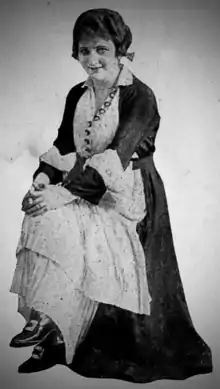 Gretchen Lederer
Gretchen Lederer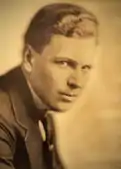 Emory Johnson
Emory Johnson Adaptation by Olga Printzlau
Adaptation by Olga Printzlau Ernst Luz Music Suggestions
Ernst Luz Music Suggestions
See also
I. G. Edmonds (1977). Big U: Universal in the silent days. A. S. Barnes, Incorporated. ISBN 978-0-498-01809-1.
Clive Hirschhorn (2000). The Universal Story. Hamlyn. ISBN 978-0-600-59736-0.
References
- Printzlau, Olga (October 21, 1916). "Motion Picture Studio Directory and Trade Annual 1916". Motion Picture News. New York, Motion Picture News, Inc. Retrieved May 25, 2019.
- Dane Coolidge (November 2001). Man from Wyoming. Dorchester Publishing Company, Incorporated. ISBN 978-0-8439-4938-4.
- "The Yaqui". catalog.afi.com.
- "The Yaqui". www.tcm.com.
- Munsey's Magazine. Frank A. Munsey Company. 1914.
- The Yaqui Girl at IMDb
- Hilger, Michael (October 16, 2015). Native Americans in the Movies: Portrayals from Silent Films to the Present. Rowman & Littlefield. p. 393. ISBN 9781442240025.
- Michael Zmuda (April 30, 2015). The Five Sedgwicks: Pioneer Entertainers of Vaudeville, Film and Television. McFarland. pp. 54–. ISBN 978-0-7864-9668-6.
- B movies (Hollywood Golden Age)# Roots of the B movie: 1910s–1920s
- "Famed Movie Producer Lives Quietly in S.M. He Loves". The Times (San Mateo, California). July 25, 1959. p. 21 – via genealogybank.com.
- Mark, Jay. "1916 film led to failed effort to create 'Hollywood of Arizona'". azcentral.com. USA Today Network. Retrieved May 31, 2019.
- "Timely Bluebird Photoplays". The Moving Picture World. New York, Chalmers Publishing Company. April 8, 1916. Retrieved May 27, 2019.
- Kawin, Bruce F. (1987). How Movies Work. University of California Press. p. 46. ISBN 9780520076969.
- Max Winkler at IMDb
- "Accessory News Section". Motion Picture News. New York, Motion Picture News, Inc. April 29, 1916. Retrieved May 25, 2019.
- "The Yaqui Review". Motion Picture News. New York, Motion Picture News, Inc. March 16, 1916. Retrieved May 25, 2019.
- "The Yaqui". Variety. New York, NY: Variety Publishing Company. March 10, 1916. Retrieved May 25, 2019.
- "The Yaqui". Moving Picture World. New York, Chalmers Publishing Company. March 18, 1916. Retrieved May 25, 2019.
- "BLUEBIRD 'PINIONS". Motion Picture News. New York, Motion Picture News, Inc. March 16, 1916. Retrieved May 29, 2019.
- Pierce, David. "The Survival of American Silent Films: 1912-1929" (PDF). Library Of Congress. Council on Library and Information Resources and the Library of Congress. Retrieved May 16, 2019.
- The Library of Congress American Silent Feature Film Survival Catalog: The Yaqui / Lloyd B Carleton (motion picture)